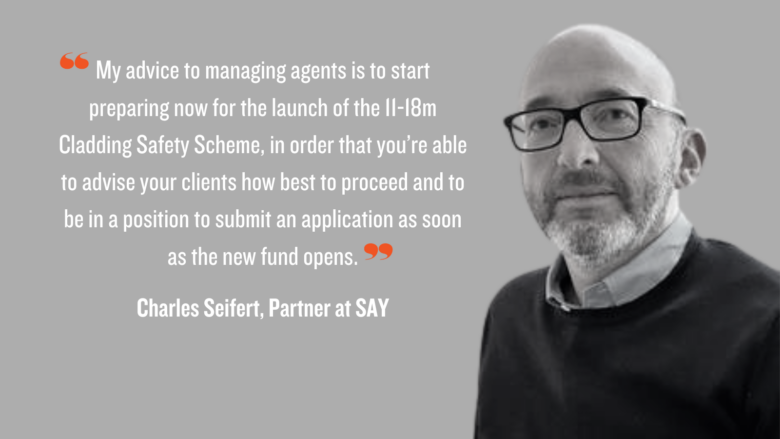Combustible cladding remediation
Charles Seifert has looked at some of the potential challenges in making a successful application to the coming 11-18m Cladding Safety Scheme for combustible cladding remediation.
This article was published in The Property Institute’s AQD magazine in April 2023.
It now looks like the government are proposing to launch the 11-18 metre Cladding Safety Scheme for combustible cladding remediation in Q2 2023. In this article I have considered some of the challenges that maybe faced when applying.
The Department for Levelling Up Housing and Communities estimated in a research document published in May 2022, that there are between 6,220 and 8,890 mid-rise (11-18m) residential buildings that will require remediation or partial remediation of external wall systems to alleviate life-safety fire risk, this is out of a mid-rise building population that they estimate to be between 71,000 – 79,000 buildings.
Based on the significant number of buildings requiring remediation, I suspect the government are going to find it challenging to process applications quickly, consequently, I suggest that managing agents should be preparing now, and if possible, be ready to submit applications as soon as the fund opens. In my experience, the earlier an application is submitted, the sooner it is dealt with.
To submit an application to establish building eligibility, an extensive pack of ‘golden thread’ type information needs to be assembled. This task can be challenging in itself; however, the government has made it significantly more challenging to make a successful application. I have identified below three of the more complex issues that managing agents will need to consider.
1 Who built the building?
The government introduced leaseholder protections in the Building Safety Act 2022, they included financial protections for leaseholders in buildings above 11 metres with historical safety defects. The government now see themselves as the funder of last resort, they have been clear that developers must pay to fix buildings they had a role in developing or refurbishing, even where they no longer own the building. As a result, the government have identified a ‘waterfall’ of liability to determine which party is responsible for remediation:
- If one of the 49 Pledge developers constructed the building, then (subject to signing the pledge) they have given a commitment to remediate life-safety fire risk defects in buildings they constructed in the past 30 years. It has been my experience working on a number of pledge developer built buildings, that different developers are embracing these obligations in different ways, some are stepping up, whilst others are less eager to remediate.
- In the event that the building was not developed by a pledge developer, the government require building owners who are – or are associated with – the developer to pay for the remediation of historical safety defects. This requirement extends to the original developers who may no longer hold an interest in the building, even where they are insolvent. The Courts have been granted new powers to extend liability to associated companies. This has been designed to ensure that cases for claims against defective buildings can be brought against companies associated with a developer, preventing the use of complex corporate structures to avoid liability.
- In the event that there is neither a pledge developer, an associated developer or a qualifying building owner, then the MRS should meet the costs of remediation (subject to eligibility).
2 What is the nature of the risk posed by the external wall system?
When the ACM and BSF opened, the presence of combustible material identified by an EWS1 survey was sufficient for an application to be considered eligible. However, the government have now adopted a risk based approach. PAS 9980:2022 is a code of practice which sets out a method for competent professionals to conduct Fire Risk Appraisals of External Wall construction (FRAEW). Applicants are now required to submit an FRAEW to determine the building’s eligibility.
I recommend that if you haven’t already done so, you instruct an FRAEW. If you currently have an EWS1, the costs of converting this to an FRAEW should not be prohibitive.
One of the challenges with remediating based on the recommendations contained in a FRAEW is that it is possible to remediate, to reduce life safety risk in the event of fire or structural failure, but for the resulting EWS1 classification to only move from B2 to B1, which can be problematic for potential purchasers (and lenders).
3 Is funding available to progress the investigations and applications?
Qualifying leaseholders are protected from meeting any of the legal costs associated with historical cladding remediation costs together with the costs of the building owner pursuing remediation costs, via legal action. This does raise an interesting question how it is going to be possible to fund action against developers or owners who are not prepared to acknowledge their obligations. Hopefully landlords will step in and fund this expenditure, however in the case of RMC’s it may be necessary to raise a fighting fund outside the service charge.
My advice to managing agents is to start preparing now for the launch of the 11-18m MRS, in order that you’re able to advise your clients how best to proceed and to be in a position to submit an application as soon as the new fund opens.
Charles Seifert FRICS is a partner at SAY property Consulting, he specialises in building safety and service charge dispute resolution.

Comments are closed.